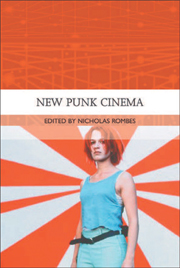Book contents
- Frontmatter
- Contents
- Notes on the Contributors
- Acknowledgements
- Introduction
- PART I BACKGROUNDS AND CONTEXTS
- PART II SCREENING NEW PUNK CINEMA
- PART III CASE STUDIES
- 10 Dogma Brothers: Lars von Trier and Thomas Vinterberg
- 11 Mike Figgis: Time Code and the Screen
- 12 What Was the Neo-Underground and What Wasn't: A First Reconsideration of Harmony Korine
- 13 Repo Man: Reclaiming the Spirit of Punk with Alex Cox
- Bibliography
- Index
11 - Mike Figgis: Time Code and the Screen
from PART III - CASE STUDIES
Published online by Cambridge University Press: 05 August 2013
- Frontmatter
- Contents
- Notes on the Contributors
- Acknowledgements
- Introduction
- PART I BACKGROUNDS AND CONTEXTS
- PART II SCREENING NEW PUNK CINEMA
- PART III CASE STUDIES
- 10 Dogma Brothers: Lars von Trier and Thomas Vinterberg
- 11 Mike Figgis: Time Code and the Screen
- 12 What Was the Neo-Underground and What Wasn't: A First Reconsideration of Harmony Korine
- 13 Repo Man: Reclaiming the Spirit of Punk with Alex Cox
- Bibliography
- Index
Summary
In an essay entitled ‘Towards an Archaeology of the Computer Screen’, Lev Manovich describes four developmental stages in the screen's history: the classical screen of painting and photography, the dynamic screen of cinema, the real-time screen of television, and the interactive screen of the computer (Manovich 1998: 27–34). While this genealogy contributes to a broad understanding of screen technologies and visual cultures, recent new punk cinemas, and the mainstream and experimental film traditions upon which they draw, complicate Manovich's proposal. More specifically, Manovich claims that the arrival of the television and computer screen displaces the single ‘window’ that completely dominates the cinematic screen (ibid.pp.28–9). Such a suggestion is complicated not only by the many and different historical examples of feature films that employ multiple windows – Napoleon (1927), Pillow Talk (1959), Woodstock (1970), Wicked, Wicked (1973), Dressed to Kill (1980), Buffalo 66 (1997), Requiem for a Dream, Kill Bill, Vol. 1 (2003) – but also a tradition of experimental film, most notably Andy Warhol's The Chelsea Girls (1966). Warhol's epic, dual-projection film was a spectacularly successful attempt to break down the ‘art of duality’ – the visual (experimental) and narrative (mainstream) modes of film-making – that polarised the New American Cinema of the early to mid-1960s (Warhol 1983: 139). More recently, the Warhol legacy – the ongoing exchange between the industrial and the artisan – can be found in the likes of the parallel plotting of films such as Short Cuts (1993) and Magnolia (1999), the surveillance television of Big Brother, and the real-time web phenomenon of JenniCAM.
- Type
- Chapter
- Information
- New Punk Cinema , pp. 168 - 179Publisher: Edinburgh University PressPrint publication year: 2005



